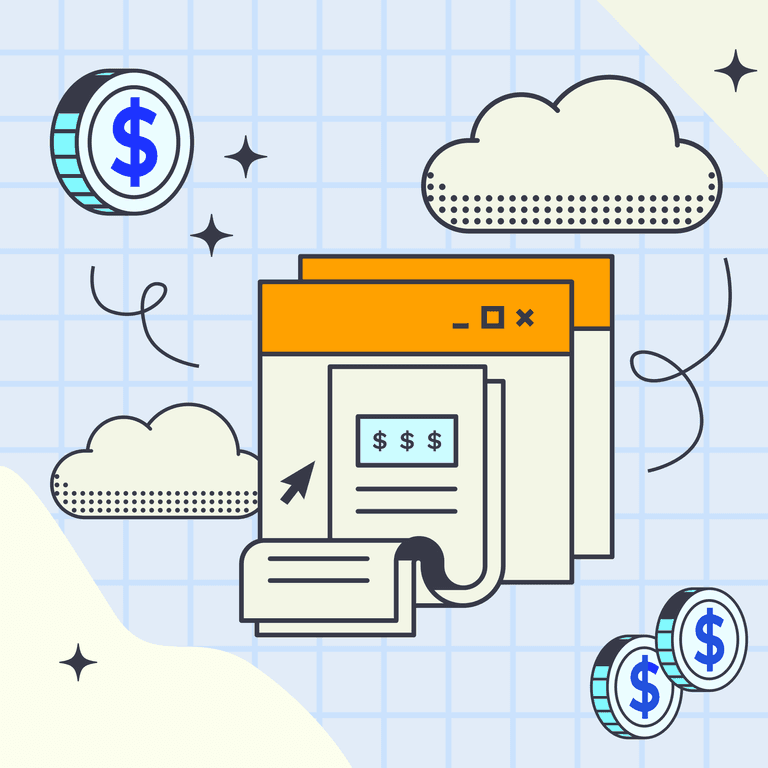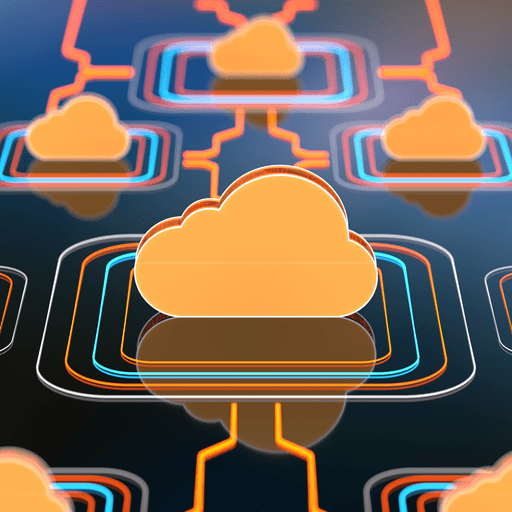
A Guide to Cloud-Based Invoicing for Mid-Sized Companies and Enterprises
- 10 min read
Despite the scale of their business, some enterprise companies' billing and payment processes still reflect those of a mom-and-pop shop.
In this blog, we'll discuss why cloud-based invoicing is uniquely suited to B2B mid-sized and enterprise companies and what to consider when looking for enterprise-ready invoicing software.

Enterprises have heartily embraced technology to transform their businesses. But one area they seem to neglect is the accounts receivable (AR) department.
In partnership with Wakefield Research, we recently surveyed 1,000 c-level executives at companies with a minimum annual value of $100 million USD about the state of their AR operations. In it, 60% of respondents acknowledged that their AR departments have been underprioritized for digitization.
To send their sometimes hundreds of thousands of monthly invoices, some enterprises still rely on manual and paper based invoicing. The result is costly errors in the invoicing process and collection delays.
Cloud invoicing, on the other hand, automates invoice delivery and speeds up collections. In this guide, we’ll explore:
- What cloud invoicing is
- 6 advantages of cloud-based invoicing for mid-sized companies and enterprises, and
- What to consider when evaluating cloud-based invoicing software
What is cloud invoicing?
Cloud invoicing refers to companies’ use of cloud-based software to create, issue, and collect on invoices automatically. Cloud-based invoicing is central to AR departments’ goals of collecting payments on time, minimizing invoice disputes, and reducing inefficiencies.
Because the AR lifecycle begins with invoice creation, automating this process has positive ripple effects on every step that follows.
Manual invoicing creates hiccups along the AR cycle
Despite digital transformation efforts seeping through several industries, AR remains rooted in manual processes.
For many enterprise-level companies, the AR cycle begins with teams manually creating, printing, and mailing paper invoices.
Between the time it takes your team to prepare and ship invoices and for customers to receive them (and that’s if they are indeed working from their office), these practices delay the start of your payment terms. This ultimately leaves you waiting unnecessarily long for your cash.
What’s more, a lack of digitization in the invoicing process makes for a more complicated cash application process down the line. Sending invoices through the mail presumably means you expect payment through the mail too (in the form of a check). This makes for a highly manual application process.
As a result, companies experience knock-on effects such as delayed availability of cash and fewer sales. For instance, a delay in cash application could mean a credit hold is placed on a customer’s account. This prevents that customer from making further purchases even though they’ve already paid their balance.
Digitized vs. fully automated invoicing
But what if instead of sending out your invoices through snail mail, you’re emailing them?
Did you still have to create the invoice in a program like Word or Excel? Or, did you have to download the invoice from your enterprise resource planning (ERP) system and then email it?
That’s still a lot of work for your AR team.
Processes such as these merely transfer manual tasks onto electronic channels. To unlock the most efficiencies possible in their AR processes, finance leaders need to be thinking about how they can remove the burden of manual tasks from their team’s plate. That means focusing not simply on digitization but on true transformation.
With the extra time that automating invoice delivery affords them, AR teams could spend more time on forecasting and analysis.
Digitally transforming AR goes beyond digitizing a few tasks while relying on manual processes in other areas. Cloud invoicing software is a critical first step in radically transforming your organization's approach to AR.
Why get on the cloud
The cloud brings an important edge to transforming the invoicing process, as it allows users to access information no matter where they’re located.
If an AR team uses software to create an invoice but stores that data locally (as with on-premise software), this isn’t much help for collaborating with team members.
With cloud-based invoicing, however, AR departments can ensure anyone on their team has access to any invoice. This especially comes in handy if ever a customer asks you to resend their invoice.
Cloud invoicing also reduces information silos that impede your business. For instance, in a platform like Versapay, any AR team member (or even from other departments like sales or customer support) can refer to supporting documentation when handling an invoice dispute.
In some cases cloud-based invoicing software features an online portal just for your customers. There, they can view all invoice-related documents, removing the need to search through email attachments.
6 advantages of cloud-based invoicing for mid-sized and enterprise companies
Cloud-based invoicing management offers the following advantages to mid-sized and enterprise companies:
1. Handle large invoice volumes easily
Cloud-based invoicing can help you automate invoice creation, distribution, and follow-up. An enterprise AR team might be sending over 500,000 invoices every month. That's a task that could fill several employees’ entire workload if done manually.
But with a tool that allows you to deliver these invoices automatically, your AR team will free up a lot of time for higher-value work.
Automating invoice creation (by pulling line item details directly from your ERP and formatting them into your desired template) also eliminates errors caused by manual data entry. Errors like entering incorrect prices, item details, and payment terms are key reasons for disputes and payment delays.
2. Support omnichannel invoicing
Your customers each have their own unique invoicing needs. Cloud invoicing platforms are better-equipped help to support omnichannel invoicing. That means you can deliver invoices in whatever formats your customers prefer—be it email, customer portal, or electronic data interchange—which helps drive faster payment times.
Many of your customers likely use disparate accounts payable (AP) platforms to automate invoice processing and prefer to receive all invoices from suppliers there. This creates a lot of work for AR teams because they require multiple AP portal log-ins and must key in the invoice information manually.
Multiply this for tens of thousands of invoices and this is impossible for AR teams to support. A cloud-based invoicing platform that can seamlessly integrate with AP portals helps eliminate this challenge and enable faster collections.
3. Automate cash application
With the volume of invoices AR teams at mid-size and enterprise companies deal with every month (anywhere from tens to hundreds of thousands), manually reconciling payments and remittance information to these invoices is a time-consuming and ineffective use of resources.
Cloud-based invoicing platforms enable better cash application and less clerical work when recording payments since invoices are already digitized. If the platform you send invoices through also allows you to collect payments online, then you eliminate the work of cash application altogether. When customers make their payments, they’re self-identifying the invoices they’re paying, making it easy for you to close them in your records.
Moving your invoice creation and delivery to the cloud is the first step to automating the complete AR lifecycle.
4. Improve customer experience
Self-service is a pillar of great customer experiences in business. But when it comes to B2B billing and payments, these opportunities are often few and far between.
The more work you create for customers to find and pay their invoices, the more your customer experience takes a hit.
Cloud-based invoicing platforms centralize data and allow you to easily share it with your customers. When customers can log into an online portal and find out what they owe at a glance, your AR team will receive fewer inquiries and follow up on overdue payments less often.
Prioritizing customers’ experience at all stages of their journey—including billing and payment—has real implications on your bottom line. In our survey with Wakefield, 82% of respondents revealed that issues in the invoicing phase inhibited new opportunities in their business.
5. Improve collections visibility
Some cloud invoicing platforms go as far as showing you when a customer has seen your invoice. No more blindly hoping that a customer has read your email. This helps your AR team better track the status of collections and arms them with the right context when following up on overdue payments.
And, with all your invoice data aggregated in one platform, you can get a view into any broader trends regarding open invoices.
6. Secure and scale infrastructure easily
Data security is paramount these days. And the bigger your company, the larger the target on your back for potential fraudsters.
Using a cloud service provider for invoice automation simplifies infrastructure maintenance and security, since these companies specialize in storage operations and complete software updates without the need for your IT’s involvement.
Cloud solutions also offer growing companies a seamless way to upgrade their capabilities (usually packaging their offerings into tiers). This helps you scale your invoice automation as your business grows, without the need for more IT investment.
What to look for in enterprise-ready cloud invoicing software
Here are a few factors to consider when evaluating a cloud-based invoicing software platform:
Integrations
How well does the platform integrate with your ERP platform or financial management system? Having deep integrations between the invoicing system and your primary accounting system prevents duplicate work like having to reconcile information in two places.
Some ERP software companies have online marketplaces showing the vendors that already work with their technology ecosystem. When speaking to potential vendors, come prepared with a list of systems you would need your cloud invoicing solution to integrate with.
Document storage
AR and AP teams alike interact with several documents throughout the invoice-to-cash process, whether it’s a sales order, credit note, or contract. Make it easy for your team—and your customers—to retrieve any documentation related to an invoice with a solution that can store those files with the invoice.
Your AR team will save valuable time by no longer searching through files any time a team member or customer needs a document.
Customization
A good cloud-based invoicing platform should allow you to customize your invoice templates and workflows. ERP platforms tend to have limited formatting options if you’re creating your invoices in them natively. Opting for an invoicing platform with greater design customization allows you to better present your brand during the billing experience.
Your customers might also have varied invoice processing requirements based on the nature of their business or their location. When researching cloud invoicing solutions, consider the level of invoice personalization your customers need and whether the platform can deliver on this.
Visibility
Consider how many departments within your company will need to access information about customers’ invoices. Will any other teams—like sales, or property managers in the case of commercial real estate—be interacting with customers about their invoices?
Look for a cloud invoicing platform that will provide access to any employee (especially those in customer-facing roles) who needs to view that information. This will ultimately save your team from having to act as the middle person when it comes to answering billing and payment-related questions.
Cloud-based invoicing with Versapay
Versapay's Collaborative AR platform makes it easy for you to centralize and automate all your AR operations—starting with invoicing. Your customers can also access their invoices and account statuses any time through a self-service portal.
Here are just a few things you can achieve with Versapay:
- Omnichannel invoicing—Accommodate all your customers' invoicing needs and get paid faster.
- Automate cash application—Apply incoming payments to invoices automatically.
- Centralize all invoice-related documents—Invoices stay united with their supporting documentation.
- Better collections—Give your AR team an audit trail of all collections activity.
- Personalization—Customize invoices with custom data fields and relevant information as required.
Learn more about Versapay’s cloud-based omnichannel invoicing and how it reduces AR costs, speeds up collections, and improves customers’ experience.
About the author

Vivek Shankar
Vivek Shankar specializes in content for fintech and financial services companies. He has a Bachelor's degree in Mechanical Engineering from Ohio State University and previously worked in the financial services sector for JP Morgan Chase, Royal Bank of Scotland, and Freddie Mac. Vivek also covers the institutional FX markets for trade publications eForex and FX Algo News. Check out his LinkedIn profile.
Cloud-based Accounting
Discover how the cloud empowers AR teams to collaborate effortlessly, work more efficiently, and keep cash flowing.


